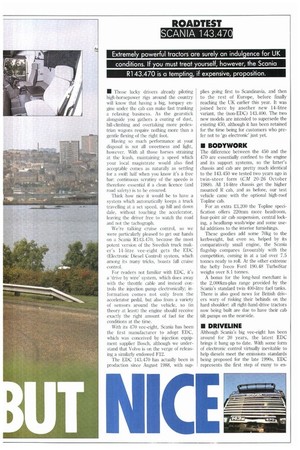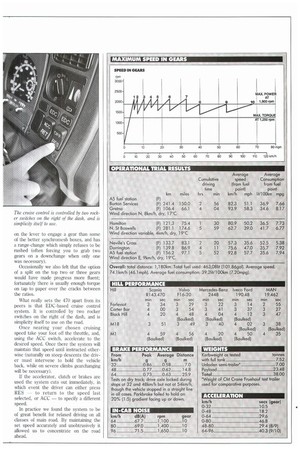MI Those lucky drivers already piloting high-horsepower rigs around the
Page 31

Page 32

Page 33

If you've noticed an error in this article please click here to report it so we can fix it.
country will know that having a big, torquey engine under the cab can make fast trunking a relaxing business. As the gearstick alongside you gathers a coating of dust, hill-climbing and overtaking more pedestrian wagons require nothing more than a gentle flexing of the right fool.
Having so much performance at your disposal is not all sweetness and light, however. With all those horses straining at the leash, maintaining a speed which your local magistrate would also find acceptable comes as naturally as settling for a swift half when you know its a free bar: continuous scrutiny of the speedo is therefore essential if a clean licence (and road safety) is to be ensured.
Think how nice it would be to have a system which automatically keeps a truck travelling at a set speed, up hill and down dale, without touching the accelerator, leaving the driver free to watch the road and not the tachograph.
We're talking cruise control, so we were particularly pleased to get our hands on a Scania K143.470, because the most potent version of the Swedish truck maker's 14-litre vee-eight gets the EDC (Electronic Diesel Control) system, which among its many tricks, boasts full cruise control.
For readers not familiar with EDC, it's a 'drive by wire' system, which does away with the throttle cable and instead controls the injection pump electronically; information comes not only from the accelerator pedal, but also from a variety of sensors around the vehicle, so (in theory at least) the engine should receive exactly the right amount of fuel for the conditions at the time.
With its 470 vee-eight, Scania has been the first manufacturer to adopt EDC, which was conceived by injection equipment supplier Bosch, although we understand that Volvo is on the verge of releasing a similarly endowed F12.
The EDC 143.470 has actually been in production since August 1988, with sup
plies going first to Scandinavia, and then to the rest of Europe, before finally reaching the UK earlier this year. It was joined here by another new 14-litre variant, the (non-EDC) 143.400. The two new models are intended to supersede the existing 450, although it has been retained for the time being for customers who prefer not to 'go electronic' just yet.
• BODYWORK
The difference between the 450 and the 470 are essentially confined to the engine and its support systems, so the latter's chassis and cab are pretty much identical to the 143.450 we tested two years ago in twin-steer form (CM 20-26 October 1988). All 14-litre chassis get the higher mounted K cab, and as before, our test vehicle came with the optional high-roof Topline cab.
For an extra £.3,200 the Topline specification offers 220mm more headroom, four-point air cab suspension, central locking, a headlamp wash/wipe and some useful additions to the interior furnishings.
These goodies add some 70kg to the kerbweight, but even so, helped by its comparatively small engine, the Scania flagship compares favourably with the competition, coming in at a tad over 7.5 tonnes ready to roll. At the other extreme the hefty lveco Ford 190.48 TurboStar weighs over 8.1 tonnes.
A bonus for the long-haul merchant is the 2,000km-plus range provided by the Scania's standard twin 400-litre fuel tanks. There is also good news for British drivers wary of risking their behinds on the hard shoulder: all right-hand-drive tractors now being built are due to have their cab tilt pumps on the nearside.
• DRIVELINE
Although Scania's big vee-eight has been around for 20 years, the latest EDC brings it bang up to date. With some form of electronic control virtually inevitable to help diesels meet the emissions standards being proposed for the late 1990s, EDC represents the first step of many to en sure an engine's fuel supply is accurately controlled.
For example, following EDC, in which electronics manage a standard in-line pump, we can expect unit injectors, so that each cylinder gets its own electronically controlled injection pump in the head.
Returning to the present, however, the main physical change with EDC is that the mechanical centrifugal governor is replaced by electronics which can adjust the control rack more rapidly and more accurately. Exactly how much fuel is delivered is decided by the microprocessor based on the information it gets from the various sensors (as shown on page 32).
We described much of the potential of EDC in our Eurotest of the R143.470 earlier this year (CM 5-11 April). Aside from the cruise control, it promises a better torque spread; variable engine speed governing (revs are limited to 1,900 rather than 2,100rpm in the top three gears); accurate control of engine speed when using a PT-0; and improved cold starting, with protection against over-revving.
Compared with the conventionally fuelled 450, the EDC 470 gains 15kW to peak at 346kW (464hp) at 1,900rpm, while torque is up by 25Nm to 1,94 ONm (1,4311bft), at a highish sounding 1,250rpm. However, more than 1,900Nm is on tap between 1,050 and 1,500rpm.
Since the combustion system itself is the same as the 450's, however, full-load fuel consumption has not been changed, with the minimum SFC staying at 191g/ kWh, though the air-to-air charge-cooled 14-litre Scania diesel remains among the most efficient engines of its size.
The remainder of the driveline is also as on the 450, which naturally means Scania's in-house products, including the GR880 10-speed range-change synchromesh gearbox which was introduced with the 143s. The GR880 got wider and stronger gears than the old GR871, with improved lubrication, and the option of a torque converter for heavy haulage applications.
• PERFORMANCE
In common with the other sweettorqueing high-power units we have experienced, the Scania 470 woos its driver with a combination of strength and refinement which makes hauling 38 tonnes something of a pleasure. The vee-eight remains smooth across a wide rev range (the green band stretches from 1,2001,80Orpm), and even when working hard in hilly country, the noise levels are low.
We are less impressed with the GR880 transmission. It needs a stronger shove on the lever to engage a gear than some of the better synchromesh boxes, and has a range-change which simply refuses to be rushed (often forcing you to grab two gears on a downchange when only one was necessary).
Occasionally we also felt that the option of a split on the top two or three gears would have made progress more fluent; fortunately there is usually enough torque on tap to paper over the cracks between the ratios.
What really sets the 470 apart from its peers is that EDC-based cruise control system. It is controlled by two rocker switches on the right of the dash, and is simplicity itself to use on the road.
Once nearing your chosen cruising speed take your foot off the throttle, and, using the ACC switch, accelerate to the desired speed. Once there the system will maintain that speed until instructed otherwise (naturally on steep descents the driver must intervene to hold the vehicle back, while on severe climbs gearchanging will be necessary).
If the accelerator, clutch or brakes are used the system cuts out immediately, in which event the driver can either press RES to return to the speed last selected, or ACC to specify a different speed.
In practice we found the system to be of great benefit for relaxed driving on all classes of main road. By maintaining the set speed accurately and unobtrusively it allowed us to concentrate on the road ahead.
















































































































